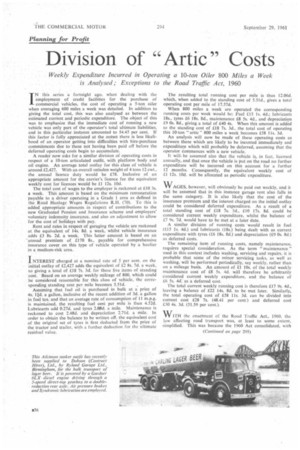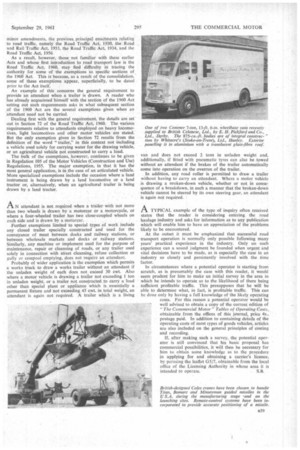Planning for Profit
Page 70

Page 73

If you've noticed an error in this article please click here to report it so we can fix it.
Division of " Artie " Costs
Weekly Expenditure Incurred in Operating a 10-ton Oiler 800 Miles a Week is Analysed; Exceptions to the Road Traffic Act, 1960
IN this series a fortnight ago, when dealing with the employment of credit facilities for the purchase of commercial vehicles, the cost of operating a 5-ton oiler when averaging 600 miles a week was detailed. In addition to giving the total cost, this was also analysed as between the estimated current and periodic expenditure. The object of this was to emphasize that the immediate cost of running a new vehicle was only part of the operator's total ultimate liabilities, and in this particular instance amounted to 54.45 per cent. If this factor is fully appreciated at the outset there is less likelihood of an operator getting into difficulties with hire-purchase commitments due to these not having been paid off before the deferred operating costs begin to accumulate.
A reader now asks for a similar division of operating costs in respect of a 10-ton articulated outfit, with platform body and oil engine. An average total outlay for this class of vehicle is around £2,427. With an overall unladen weight of 4 tons 12 cwt., the annual licence duty would be /78. Inclusive of an appropriate amount for the carrier's licence fee the equivalent weekly cost for licences would be 11 12s. 10(1.
The total cost of wages to the employer is reckoned at 1.10 3s. a week. This amount is based on the minimum remuneration payable to a driver operating in a Grade I area as defined in the Road Haulage Wages Regulations R.H. (70). To this is added appropriate amounts in respect of contributions to the new Graduated Pension and Insurance scheme and employers' voluntary indemnity insurance, and also an adjustment to allow for the cost of holidays with pay.
Rent and rates in respect of garaging the vehicle are reckoned at the equivalent of 14s. 8d. a week, whilst vehicle insurance adds £3 8s. 2d, a week. This latter amount is based on an 'annual premium of /170 8s., payable for comprehensive insurance cover on this type of vehicle operated by a haulier in a medium-risk area.
INTEREST charged at a nominal rate of 5 per cent, on the initial outlay of £2,427 adds the equivalent of 12 8s. 7d. a week, so giving a total of .£18 7s. 3d. for these five items of standing cost. Based on an average weekly mileage of 800, which could be considered reasonable for this class of vehicle, the corresponding standing cost per mile becomes 5.5Id. Assuming that fuel oil is purchased in bulk at a price of 4s, lid. a gallon, inclusive of the recent addition of 3d. a gallon in fuel tax. and that an average rate of consumption of 11 m.p.g. is maintained, the resulting .fuel cost per mile is then 4.52d. Lubricants add 0.27d. and tyres 2.08d. a mile. Maintenance is reckoned to cost 2.48d. and depreciation 2.71d. a mile, In order to obtain the balance to be written off, the equivalent cost of the original set of tyres is first deducted from the price of the tractor and trailer, with a further deduction for the ultimate residual value. The resulting total running cost per mile is thus I2.06d. which, when added to the standing cost of 5.51d., gives a total operating cost per mite of 17.57d.
When 800 miles a week are operated the corresponding running costs per week would be: Fuel 115 Is. 4d.; lubricants I8s., tyres £6 18s. 8d., maintenance £8 5s. 4d., and depreciation £9 Os. 8d„ giving a total of £40 4s. When this amount is added to the standing cost of £18 7s. 3d., the total cost of operating this 10-ton " artic 800 miles a week becomes £58 Ils. 3d.
An analysis will now be made of these operating costs as between those which are likely to be incurred immediately and expenditure which will probably be deferred, assuming that the operator commences with a new vehicle.
It will. be assumed also that the vehicle is, in fact, licensed annually, and that once the vehicle is put on the road no further expenditure will be incurred on this account for a further 12 months. Consequently, the equivalent weekly cost of £1 12s. I0d. will be allocated as periodic expenditure.
WAGES, however, will obviously be paid out weekly, and it will be assumed that in this instance garage rent also falls in the same category. It is also likely that the cost of the insurance premium and the interest charged on the initial outlay could be considered deferred expenditure. As a result of a total standing cost of 118 7s. 3d., £10 17s. 8d. could be considered current weekly expenditure, whilst the balance of 17 9s. 7d. would have to be met at a later date.
A similar division of running costs 'would result in fuel (£15 Is. 4d.) and lubricants (I8s.) being dealt with as current e,xpenditure with tyres (16 18s. 8d.) and depreciation (£9 Os. 8d.) as deferred costs.
The remaining item of running costs, namely maintenance, requires special consideration. As the term " maintenance " used in this context includes washing, servicing and repairs, it is probable that some of the minor servicing tasks, as well as washing, will be performed periodically, say weekly, rather than on a mileage basis. An amount of 11 10s. of the total weekly maintenance cost of £8 5s. 4d. will therefore be arbitrarily considered current weekly expenditure, and the balance of 16 5s. 4d as a deferred cost.
'Fhe total current weekly running cost is therefore £17 9s, 4d., leaving a balance of £22 14s. 8d. to be met later. Similarly, the total operating cost of £58 I Is. 3d. can be divided into current cost £28 7s. (48.41 per cent.) and deferred cost 130 4s. 3d. (51.59 per cent.).
WITH the enactment of the Road Traffic Act., 1960. the law affecting road transport was, at least to some extent, simplified. This was because the 1960 Act consolidated, with (('ontinued on page 295)
minor amendments, the previous principal enactments relating to road traffic, namely the Road Traffic Act, 1930, the Road and Rail Traffic Act, 1933, the Road Traffic Act, 1934, and the Road Traffic Act, 1956.
As a result, however, those not familiar with these earlier Acts and whose first introduction to road transport law is the Road Traffic Act, 1960, may find difficulty in tracing the authority for some of the exemptions to specific sections of the 1960 Act. This is because, as a result of the consolidation, some of these exemptions appear, superficially, to be dated prior to the Act itself.
An example of this concerns the general requirement to provide an attendant when a trailer is drawn_ A reader who has already acquainted himself with the section of the 1960 Act setting out such requirements asks in what subsequent section of the 1960 Act are the several exemptions given when an attendant need not be carried.
Dealing first with the general requirement, the details are set out in Section 72 of the Road Traffic Act, 1960. The various requirements relative to attendants employed on heavy locomotives, light locomotives and other motor vehicles are stated. But the only exemption given in Section 72 results from the definition of the word "trailer," in this context not including a vehicle used solely for carrying water for the drawing vehicle, or an agricultural vehicle not constructed to carry a load.
The bulk of the exemptions, however, continues to be given in Regulation 105 of the Motor Vehicles (Construction and Use) Regulations, 1955. The major exemption, in that it has the most general application, is in,the case of an articulated vehicle. More specialized exemptions include the occasion where a land instrument is being drawn by a land locomotive or a land tractor or, alternatively, when an agricultural trailer is being drawn by a land tractor.
A. N attendant is not required when a trailer with not more than two wheels is drawn by a motorcar or a motorcycle, or where a four-wheeled trailer has two close-coupled wheels on each side and is drawn by a motorcar.
Further exemptions limited to special types of work include any closed trailer specially constructed and used for the conveyance of meat between docks and railway stations, or between wholesale markets and docks or railway stations. Similarly, any machine or implement used for the purpose of maintenance, repair or cleansing of roads, or any trailer used solely in connection with street cleansing, refuse collection or gully or cesspool emptying, does not require an attendant. Probably of wider application is the exemption which permits a works truck to draw a works trailer without an attendant if the unladen weight of each does not exceed 30 cwt. Also where a motor vehicle is drawing a trailer not exceeding 1 ton in unladen weight, or a trailer not constructed to carry a load other than special plant or appliance which is essentially a permanent fixture and not exceeding 45 cwt. in total weight, an attendant is again not required. A trailer which is a living van and does not exceed 2 tons in unladen weight and, additionally, if fitted with pneumatic tyres can also be towed without an attendant if the brakes of the trailer automatically come into operation on the overrun of the trailer.
In addition, any road roller is permitted to draw a trader without having to carry an attendant. Where a motor vehicle is drawing a oroken-down vehicle, whether or not in consequence of a breakdown, in such a manner that the broken-down vehicle cannot be steered by its own steering gear, an attendant is again not required.
A TYPICAL example of the type of inquiry often received states that the reader is considering entering the road haulage industry and asks for information as to any publication which will enable him to have an appreciation of the problems likely to be encountered.
At the outset it must he emphasized that successful road transport operation is normally only possible following many years' practical experience in the industry. Only on such experience can a sound judgment be founded when urgent and vital decisions have to be made, as is especially the case in an industry so closely and persistently involved with the time factor.
In circumstances where a potential operator is starting from scratch, as is presumably the case with this reader, it would seem prudent for him to make an initial survey in the area in which he intends to operate as to the likelihood of there being sufficient profitable traffic. This presupposes that he will be able to determine what, in fact, is profitable traffic. This can be done only by having a full knowledge of the likely operating costs. For this reason a potential operator would be well advised to obtain a copy of the current edition of "The Commercial Motor" Tables of Operating COSA, obtainable from the offices of this journal, price 4s., postage paid_ In addition to containing details of the operating costs of most types of goods vehicles, articles are also included on the general principles of costing and recording.
If, after making such a survey, the potential operator is still convinced that his basic proposal has commercial possibilities, it will then be necessary for him to obtain some knowledge as to the procedure in applying for and obtaining a carrier's licence, by perusing the leaflet 05/7, obtainable from the local office of the Licensing Authority in whose area it is intended to operate. S.B.




















































































































